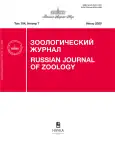Spatial structure of a population of the field vole (Microtus (agricola) agrestis L.) in the taiga of northwestern Russia
- Authors: Ivanter E.V.1,2
-
Affiliations:
- Karelian Research Centre, Russian Academy of Sciences
- Petrozavodsk State University
- Issue: Vol 104, No 7 (2025)
- Pages: 116-124
- Section: ARTICLES
- URL: https://bakhtiniada.ru/0044-5134/article/view/305037
- DOI: https://doi.org/10.31857/S0044513425070112
- EDN: https://elibrary.ru/bkijgk
- ID: 305037
Cite item
Abstract
Special studies were carried out in the territory of the Priladozhsky Theriological Research Centre (Karkku village, Pitkyaranta District, Karelia) in 1986–1997, supplemented by periodic visits between 1998–2015. By using tagging and live trapping we traced territorial relationships of 193 field voles. The number of recaptured voles amounted to 833. Adult animals of this species were found to often form microcolonies during their life, living in small family groups. Each group included 2–3 broods obtained from one pair of animals and settled in closely located habitats 10–20 m2 in area. At the northern periphery of the distribution range, characteristic differences in spatial groupings of certain age and sex groups were established. Adult (overwintering) females adhered mainly to certain individual territories with an average area of 880 m2, with fluctuations from 300 to 2200 m2. Males were considerably more mobile compared to females and occupied areas that overlapped with other males’ territories. The territorial behavior of juvenile individuals of was heterogeneous and depended on their participation in reproduction. Breeding young individuals occupied relatively smaller areas. Non-breeding individuals were mush more mobile and did not adhere to any certain territory.
Keywords
About the authors
E. V. Ivanter
Karelian Research Centre, Russian Academy of Sciences; Petrozavodsk State University
Author for correspondence.
Email: ivanter@petrsu.ru
Pushkinskaya st., 11, Petrozavodsk, 185935 Russia; Prospekt Lenina, 33, Petrozavodsk, 185910 Russia
References
- Громов В.С., 2008. Пространственно-этологическая структура популяций грызунов. М.: Товарищество научных изданий КМК. 581 с.
- Жигарев И А., 2005. Локальная плотность и индивидуальные участки рыжей полевки (Clethrionomys glareolus) в условиях южного Подмосковья // Зоологический журнал. Т. 84. Вып. 6. С. 719–727.
- Ивантер Э.В., 1975. Популяционная экология мелких млекопитающих таежного Северо-Запада СССР. Л.: Наука. 246 с.
- Ивантер Э.В., 2018. Очерки популяционной экологии мелких млекопитающих на северной периферии ареала. М.: Товарищество научных изданий КМК. 760 с.
- Ивантер Э.В., Леонтьев И.А., 2013. К изучению размножения и экологической структуры популяции темной полевки в Карелии // Труды КарНЦ РАН. № 6. С. 116–125.
- Ивантер Э.В., Макаров А.М., Якимова А.Е., 2018. О пространственной организации населения рыжей полевки (Clethrionomys glareolus Laxm.) // Зоологический журнал. Т. 97. № 12. С. 1531–1543.
- Карасева Е.В., Телицына А.Ю., Жигальский О.А., 2008. Методы изучения грызунов в полевых условиях. М.: Издательство ЛКИ. 416 с.
- Кошкина Т.В., Окулова Н.М., Аристова В.А., 1972. Территориальные отношения у грызунов и их роль в регуляции численности населения // Труды Московского общества испытателей природы. Отд. биол. Т. 48. С. 215–237.
- Наумов Н.П., 1951. Новый метод изучения экологии мелких лесных грызунов // Фауна и экология грызунов. М. Вып. 4. С. 3–21.
- Никитина Н.А., 1972. О размерах индивидуальных участков грызунов фауны СССР // Зоологический журнал. Т. 51. Вып. 1. С. 119–126.
- Bondrup-Nielsen S., 1983. Density estimation as a function of livetrapping grid home range // Canadian Journal of Zoology. V. 61. № 10. P. 2361–2365.
- Borowski Z., 2003. Habitat selection and home range size of field voles Microtus agrestis in Slowinski National Park. Poland // Acta Theriol. V. 48. № 14. P. 247–270.
- Borowski Z., Owadowska E., 2010. Field vole (Microtus agrestis). Seasonal spacing behavior the effect of predations risk by mustelids // Naturwissenschaften. V. 97. № 5. P. 487–493.
- Bujalska G., Saitoh T., 2000. Territoriality and its consequences // Polish. Ecol. 48. Suppl. P. 37–49.
- Burt W.H., 1943. Territoriality and home range concepts as applied to mammals // J. Mammal. V. 24. P. 346– 352.
- Kalela O., 1957. Regulation of reproduction rate in subarctic populations of the voles Clethrionomys rufocanus (Sund.) // Annales Academiae Scientiarum Fennica. Ser. A. V. 4. P. 7–60.
- Loughran U.F., 2007. Social organization of the male field vole (Microtus agrestis) a case of transient territoriality? // Annales Zoologici Fennici. V. 44. № 2. P. 97–106.
- Mathias M.L., Blake H.M., Ramalhinho M.G., Jaa- rola M., 2017. Microtus agrestis (Rodentia: Сricetidae) // Mammalian species. 49 (944). Campe Grande. Portugal de Lisboa. P. 23–39.
- Myllymäki A., 1977. Intraspecific competition and home range dynamics in the field vole // Oikos. V. 29. P. 553–560.
- Riotte-Lambert L., Remi A., Andreassen H., 2012. The disturbance of resident populations of field voles (Microtus agrestis) by immigrants // Ann. Zoologici Fennici. 49. P. 109–112.
- Stickel L.F., 1954. A comparison of certain methods of measuring ranges of small mammals // J. Mammal. V. 35. № 1. P. 1–15.
- Viitala J., 1977. Social organization in cyclic subarctic population of the voles Clethrionomys rufocanus (Sund.) and Microtus agrestis (L.) // Acta Zoologica Fennica. V. 14. P. 53–93.
Supplementary files









